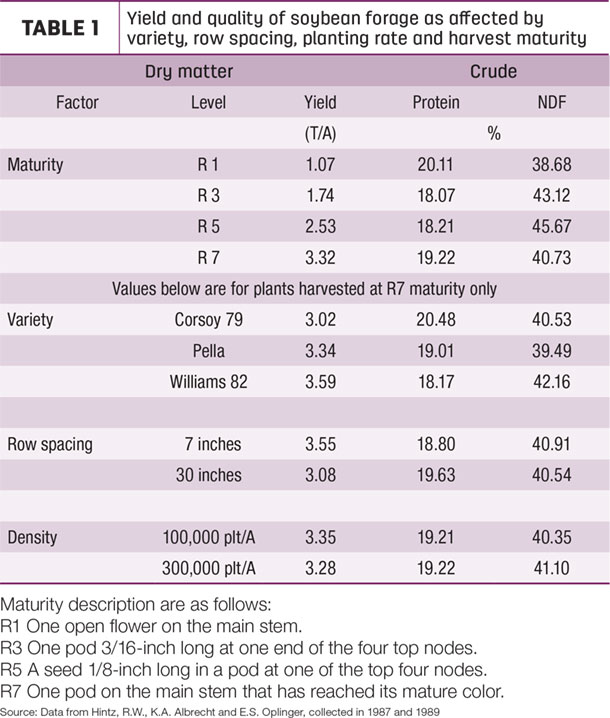The major limitations to using soybeans for forage are their relatively low yield potential and the fact that many soybean herbicides are not labeled for use when soybeans are harvested as a forage.
Soybean forage yield potential can be as high as 4 to 5 tons per acre. However, yields this high are seldom observed in the field, particularly when an emergency decision is made to harvest soybeans as forage due to drought or when the soybean grain crop is damaged (for example, following hail damage or an early frost).
Forage yield of soybeans can be maximized by planting early – when soil temperature has reached 55ºF. Soybeans may be planted as late as mid-June as an emergency crop; however, yields will be reduced to 1 to 2 tons of dry matter per acre with the late plantings. If the decision to harvest as forage is made at planting, one should plant a late-maturing variety, which tends to grow taller and produce more forage (Table 1).

There is little effect of plant population on soybean yield above 100,000 plants per acre. However, narrow row spacing (7 inches) produced more forage than wide spacing (30 inches) (Table 1).
The major limitation to emergency use of soybeans for forage is the fact that few herbicides are cleared for use on soybeans harvested for use as forage. If the decision to harvest for forage is made after application of an herbicide not cleared for use on soybeans harvested as forage, it is not legal to harvest the soybeans and use them as a forage. Check the herbicide label for information concerning specific intervals between application and harvest.
However, if the decision to harvest for forage is made early, the need for herbicides may be reduced. It is important to remember that weed control need not be as stringent when soybeans are harvested for forage as compared to grain production. Some weeds can be tolerated in forage, especially in late season, with no effect on yield and small effects on forage quality.
The optimum time to harvest soybeans for quality silage is at the green pod stage (R4). The highest yield (and quality of standing forage) is when seeds completely fill the pods and the lower leaves of the plant are just beginning to turn yellow (just before R7). However, mowing and conditioning at this stage will cause pod shatter and loss of some beans. Thus, the standing forage is higher quality at R7, but mowed forage tends to be highest quality at R4. Soybeans harvested later than R4 will have a higher oil content, which reduces their ensiling characteristics (mixing grass at ensiling will help later-harvested soybeans).
Some field drying is necessary before either ensiling or making hay from soybeans. Soybeans harvested for silage should be harvested with a mower-conditioner and dried to 65% to 70% moisture for storage in a silo tube or bunker silo. Conditioning hastens stem drying so that leaves and stems dry at more similar rates and leaf loss is reduced. Caution: check the moisture of soybeans before chopping by drying a sample in a microwave or Koster tester, since 65% moisture of soybeans will feel different than 65% moisture in alfalfa or corn silage.
Pure soybean silage is not very palatable to cattle (especially if it is more mature with a higher oil content). Ration palatability can be maintained by mixing no more than 20% soybean silage into the ration.
Palatability can be increased by mixing soybeans with a grass such as corn, sorghum, sudangrass or others when ensiling. Mixing soybeans with grass provides additional energy for fermentation and dilutes the protein of soybeans to that needed for the animals being fed. Mixing with grass may particularly improve silage fermentation if beans have begun to form and the forage has a high oil content.
Some farmers have tried mixing soybeans with corn or sorghum in the field to grow a mixed crop. This generally has not worked well, as whichever crop gets a head start predominates and the composition and quality of the mixture varies considerably from year to year. Additionally, weed control can become a problem where one is limited to herbicides that will not hurt either crop.
A far better practice is to grow the crops separately (possibly in the same field) and then mix them when chopping. If the two crops are mowed and dried to below 65% moisture, then alternating rounds of soybeans and grass may be chopped and mixed as the wagon or truck is being filled. Some Ohio data has suggested that a 2-to-1 ratio of grass to soybeans (dry matter basis) is optimum.
If harvested at the correct stage and managed properly, feeding soybeans can produce a good return. Soybeans cut in Kentucky when beans were ¾ mature resulted in greater gain than when cut later. Similar findings were noted in Illinois and Indiana. A feeding trial in Iowa showed that soybean hay was nearly equal in value to alfalfa in terms of milk and butterfat production, and a study in West Virginia showed greater production from soybean hay than alfalfa. We monitored about a dozen farmers feeding soybean silage, and they found good results feeding up to 20% of the ration as soybean silage. ![]()
References omitted but available upon request. Click here to email an editor.

-
Dan Undersander
- Forage Professor Emeritus
- University of Wisconsin
- Email Dan Undersander











